DevOps for the Sinclair Spectrum - Part 4
Updated:
This article is part of a series
- Table Of Contents - Full table of contents in Part 1
- Part 1 - Introduction, hardware, development environment, Windows/Linux buildchain and tools
- Part 2 - The server environment and building the first prototype
- Part 3 - The backend server daemon, pipelines and unit tests
- Part 4 - Wrap-up, other sites and final thoughts
In Part 3 I covered the backend server processes and protocols, CI/CD pipelines and unit tests I used to build the TNFS site. In this (much shorter) part, I’d like to take a step back from the hardcore geekery, and wrap up with my thoughts on the whole thing.
Other Sites
But before that, I’m going to explore a little part of the rest of the TNFS universe. After all, this project is intended to build a community site, and the Speccy has one of the friendliest retro computing communities out there. My site isn’t the only one out there - there’s a whole network of TNFS servers on the public internet, and the protocol has also been adopted for 8-bit Atari systems. There’s currently no central directory as such (although work is underway to create an index system using DNS TXT records) but there’s a forum thread that gets regular updates, and I have a links section on my site’s main menu.
To give you an idea of some of the great content others have built, here’s a quick overview and screenshots of some of my favourite Speccy TNFS sites…
Spectranet-related
vexed4.alioth.net
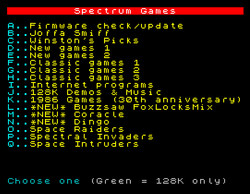
The weird and wonderful
tnfs.bytedelight.com
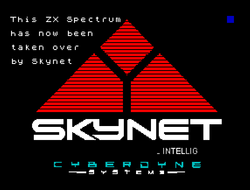
zx.zapto.org
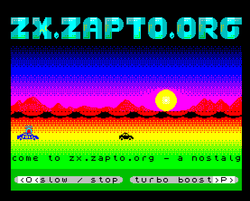
Gateways
zx.desertkun.in
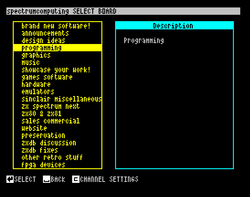
zx.desertkun.in as your proxy in the opening screen, and you can connect to internet forums and message boards including the Spectrum Computing Forums! There’s a Docker Image and source code available so you can run and customise things on your own systems. This uses a similar approach to my site where the heavy-lifting (in this case, TLS processing and connecting to/parsing the data from websites) is shifted to a more-capable modern environment. Awesome work!
irata.online
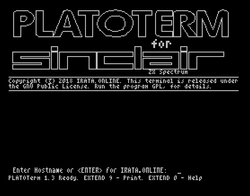
nihirash.net
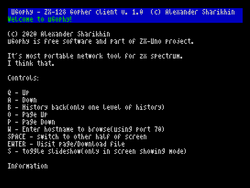
gopher.floodgap.com as a starting point. You can use a web browser to access the HTTP proxy at https://gopher.floodgap.com/gopher/ to get a useful list of links to other Gopher sites still in operation, including the Veronica-2 search engine.
zxnet.co.uk
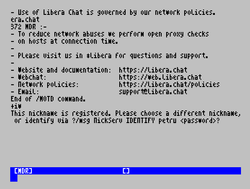
zxnet.co.uk TNFS site hosts a copy of snapCterm (see below) and an IRC gateway. The IRC gateway allows you to connect to any public IRC server network and chat with other users - try libera.chat to get started, and use their excellent online help guides to find some interesting channels to join.
snapCterm
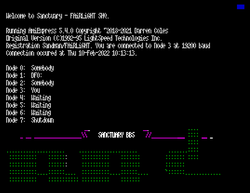
telnetd which makes it possible to access the many old-school BBS systems still running. This is how we used to “social network”, kids, before this new fangled web thing took over… There’s a great curated list of systems to connect to at https://www.telnetbbsguide.com/ including all those “elite” sites that used to be advertised all over Amiga demo/warez scene productions. You can see in the screenshot a connection starting to The Sanctuary BBS, running on AmiExpress (still being updated!) and which used to be Fairlight’s World Headquarters back in the day. SnapCTerm is available on my TNFS site (2nd menu page, option 3) as well as on sites like zxnet.co.uk.
File sites
tnfs.millhill.org
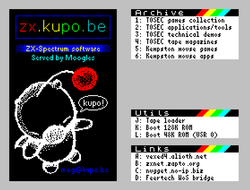
retrojen.org
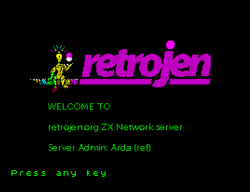
QAOP keys to move around the menu system, ENTER to select a title, 1 to jump to the first page and F to find a production by the release date. A great little archive of some old gems! Thanks for the recent post on my message wall, too :)
szeliga.zapto.org
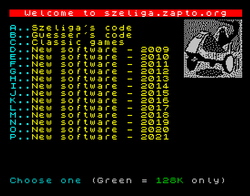
Wrap Up
Since the site went online in January 2021 it’s grown to nearly 10k lines of code, handled over 11,500 connections and has gathered a small community of users chatting, playing games and leaving messages. It’s connected me to a wonderful (if slightly crazy) network of people who care about this little squidgey-keyed black box from the 80s as much as I do. It’s been a real pleasure seeing first users come to the site and I have lots of plans still for the future! Just a few of the bits and pieces in various Git branches right now:
- Proper pagination indication on all menus (page x of y type stuff)
- Message Board improvements (big speed boost and longer retention)
- Reply to comments - this opens up the possibility of a proper message board system!
- More files to upload and more curated lists
- I’m open to suggestions! If you have any ideas or fancy writing a text article for the site, let me know…
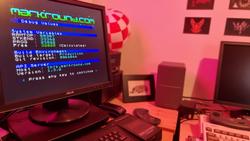
VAL$ function.
Sometimes, introducing constraints like an ancient 8-bit processor with only 48Kb of usable RAM can really force you to think “outside the box” and produce the most creative hacks. Plus, in this day and age it’s a lot of fun to do something just for the sheer hell of it! I’m also definitely going to add Sinclair BASIC to my “skills” in LinkedIn now ;)
Before I close, I’d just like to add a note of thanks to everyone who’s used my site, suggested features, left messages or helped me out with my many technical queries on forums. It’s been an absolute blast and I look forward to the next 40 years of Spectrum hacking!
-Mark, February 2022.
